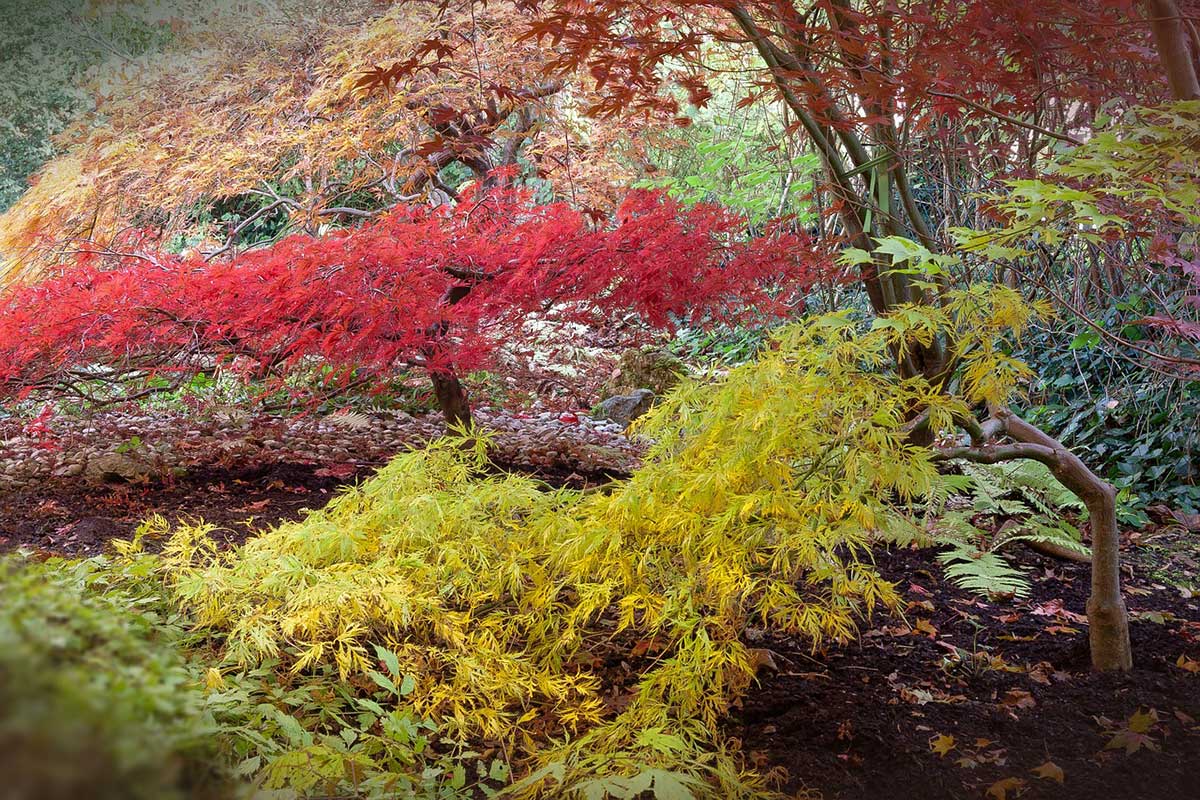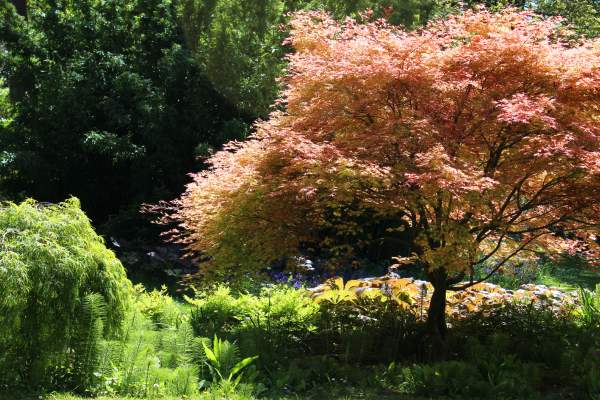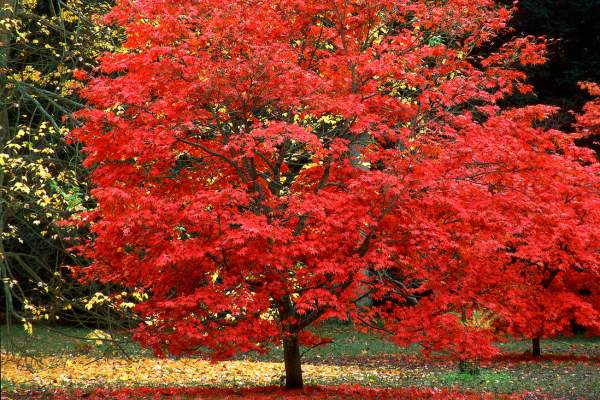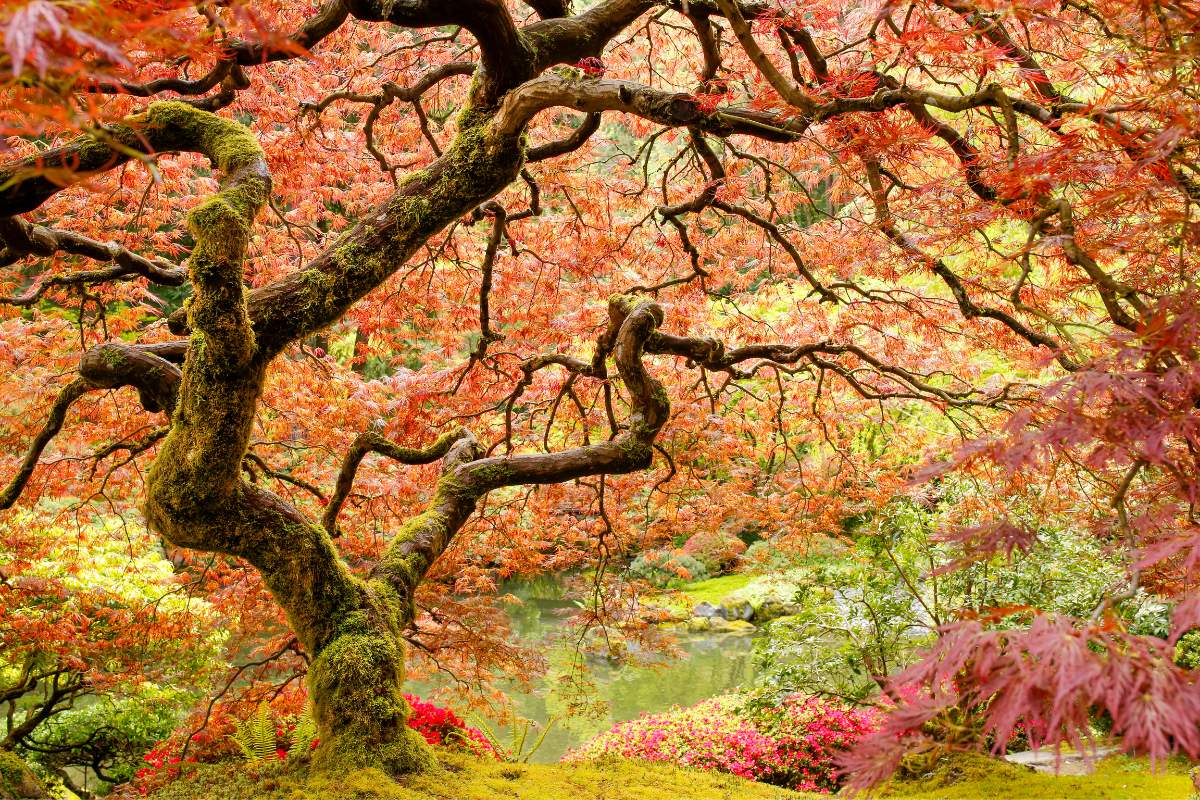If you’re looking to add a tree to your landscape, you can’t go wrong with a Japanese maple (Acer palmatum). Japanese maples are low maintenance once the tree is established and will provide year-round interest that changes from one season to the next. While these trees are iconic, there are some specific questions, such as how tall do Japanese maples get, that you should consider before making your final decision.
How tall do Japanese maples get?

A Japanese maple can range between 5-25 feet in height as a mature tree, depending on the variety. There are over 1,000 cultivars of the Japanese maple, although many have been lost over the years or are simply not cultivated in the United States. However, new cultivars are almost always in development.
Each cultivar has its own specific characteristics, including how tall it will grow. For example, the Japanese red maple can grow up to 25 feet tall, while the Beni hime variety only reaches about 4-5 feet tall.
Here are 8 popular Japanese maple varieties with heigh estimates. You can see that some stay as small as 6 feet while others may grow to 25.
- Bloodgood Japanese Maple (15-20 feet): A popular variety with deep red leaves that turn a brighter shade in the fall. It has a rounded shape and can grow up to 20 feet tall.
- Emperor Japanese Maple (15-20 feet): This variety has vibrant red leaves that turn orange in the fall. It has a broad, spreading shape and can grow up to 20 feet tall.
- Coral Bark Japanese Maple (15-25 feet): This variety has bright red bark that stands out in the winter months. Its leaves are green with red edges and it can grow up to 25 feet tall.
- Red Dragon Japanese Maple (6-8 feet): This smaller variety has deep red leaves that maintain their color throughout the growing season. It has a weeping habit and only grows up to 8 feet tall.
- Sango Kaku Japanese Maple (20-25 feet): Also known as the Coral Bark maple, this variety has bright red bark in the winter and green leaves that turn yellow in the fall. It has a vase-like shape and can grow up to 25 feet tall.
- Crimson Queen Japanese Maple (8-10 feet): This weeping variety has lacy, deep red leaves that turn a brighter shade in the fall. It has a cascading habit and typically grows up to 10 feet tall.
- Tamukeyama Japanese Maple (6-8 feet): This weeping variety has delicate, lacy leaves that are a deep red color. It has a cascading habit and typically grows up to 8 feet tall.
- Viridis Japanese Maple (6-8 feet): This weeping variety has delicate, lacy leaves that are a bright green color. It has a cascading habit and typically grows up to 8 feet tall.
These Japanese maple varieties are all popular choices for their unique colors, shapes, and sizes. When selecting a Japanese maple for your landscape, be sure to consider its maximum height and shape to ensure it will fit well in your space.
Do Japanese maples need to be trimmed?
In most cases, you won’t have to regularly prune your Japanese maple. However, that doesn’t mean there won’t come a time when pruning may be needed. No matter what type of Japanese maple you are growing, it is recommended to only perform light structural pruning during the winter season.
Wait until the summer months to remove diseased, damaged, or dead wood as this is the time when the plant is actively growing and able to handle more intense pruning.
How tall do dwarf Japanese maples get?

There are several different dwarf Japanese maple trees available, and like their larger counterparts, each variety will have different heights and widths that it typically grows up to. On average, however, most dwarf Japanese maples will reach between 3 and 8 feet tall. Additionally, dwarf Japanese maples typically have smaller leaves and shorter internodes than traditional cultivars.
What is the smallest dwarf Japanese maple?
The smallest dwarf Japanese maple tree is the Green Mist cultivar, which grows only to about 3 feet tall and 5 feet wide. This fast growing tree is hardy in USDA Plant Hardiness Zones 5 to 9 and produces feathery leaves that are long and have cut lobes. These leaves are vibrant green, but will change to a yellowish orange or scarlet during the fall season.
There are a wide variety of other dwarf Japanese maples available, including the Orion, which has a weeping form and grows to only about 4 feet tall and 7 feet wide. This dwarf variety has a bit slower growth rate and can take up to 15 years before it reaches full maturity.
How much space does a Japanese maple need?

The exact space a Japanese maple needs will also depend on the exact variety you are growing. As with the height of the tree, each type of Japanese maple has its own average width. Knowing how tall and wide the tree will give you a general idea of how much space the plant will need.
When planting Japanese maples, it is recommended to space them at least 15 to 20 feet apart. This allows enough room for the tree to grow and spread its branches without competing with neighboring trees. Additionally, it is important to ensure that the tree has enough space to receive adequate sunlight and nutrients from the soil.
Japanese maples also require sufficient space around their root systems to grow and thrive. It is recommended to plant these trees in soil that is well-drained and rich in nutrients. This will help the tree to establish a strong root system and maintain its health over time.
When planting Japanese maples, it is important to consider the amount of space they need to grow and thrive. By providing enough space and proper soil conditions, you can ensure that your Japanese maple tree will flourish and provide beauty to your landscape for years to come.
How do I select the right type of Japanese maple?
There are essentially 4 factors that you should consider when trying to decide which Japanese maple tree to add to your landscape.
These factors include:
- Zone
- Size And Form
- Leaf Color
- Leaf Shape
Zone
The hardiness zones in which the tree can grow is probably the most important factor, since some plants will just not grow in certain areas. In general, most Japanese maple trees grow in USDA Plant Hardiness Zones 5 through 8. Trying to grow the tree outside these zones will quickly cause the plant to die.
If you live in a zone higher than 8, you may still be able to grow the Japanese maple, but the chance for leaf scorching is substation in higher zones. You can help protect the plant with regular watering and protecting it from the hot sun. If you live in zone 4, consider planting the Velvet Viking since it is one of the few Japanese maple trees that can grow in zone 4.
Size
The next thing to consider is the size and form of the specific cultivar you want to grow. If you have limited space, trying to grow a traditional Japanese maple can lead to overcrowding and stress. In this instance, planting a dwarf variety may be your best option.
The growing form of the plant should also be considered, especially when you consider the vast array of growth habits available. For example, you can find Japanese maples with a weeping, upright, mounding, cascading, or rounding form.
Color
The color of the leaf is another factor that should be considered when narrowing down the various Japanese maples. Some varieties will produce stunning colors throughout the fall season, while others start off vibrant red during the spring and change to green in the summer.
In fact, Japanese maples are some of the most colorful trees out there, and can produce a wide array of leaf colors, including green, purple, red, orange, yellow, pink, and even white.
Leaf shape
The last factor that you can consider is the leaf shape, though this isn’t nearly as important to some people as the leaf color. Most Japanese maple trees can be divided into two leaf types: lacy/delicate leaves or palm-shaped.
The lacy/delicate leaf shape, also known as dissectum, has a more elegant appearance, while the palm-shaped, also known as palmatum, resembles the more common leaf shape that you are probably familiar with.
